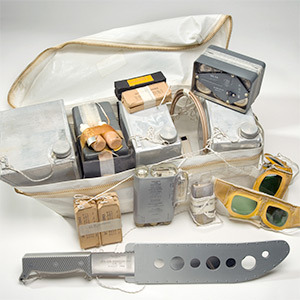May 29, 2019 — When it comes to producing commemorative items for the 50th anniversary of the first moon landing, Case has a distinctive edge.
Like other companies that supplied NASA with equipment to fly aboard the Apollo 11 spacecraft, Case was inspired by the half-century milestone to highlight its own unique contribution to the space program. But the knife manufacturer's Apollo 11 50th anniversary offering may prove that the (space) pen is not mightier than the (moon) sword.
"To celebrate the 50th anniversary of the moon landing, Case is proud to reintroduce the Case Astronaut M-1, which was originally made for NASA's Apollo and Gemini missions," the company announced on its website.
A machete on the moon
As Buzz Aldrin famously remarked on July 20, 1969, the moon is a "magnificent desolation."
The lunar surface is, of course, devoid of any overgrown plant life needing to be cleared and, as the first and only humans to arrive on the lunar surface that day, Aldrin and Neil Armstrong had no use for a weapon. So why did Aldrin, Armstrong and their crewmate in lunar orbit, Michael Collins, require a broad, heavy knife?
"The original Case Astronaut Knife M-1's traveled to the moon and back nine times as part of a survival pack on board the spacecraft used in every Gemini and Apollo space mission led by NASA," the company explained.
Among the supplies flown aboard the Apollo 11 command module "Columbia" was the equipment needed for the crew to survive for two days after an off-course landing on Earth. In addition to water containers, a radio beacon, three pairs of sunglasses and two bottles of sunscreen was one W.R. Case & Sons Cutlery Co. machete.
"When other military knives did not meet NASA's criteria for the start of the Apollo program, the organization commissioned Case to create a knife to [its] exact specifications. The Case Astronaut Knife M-1 was designed to be lightweight and featured a sharp cutting edge partnered with saw teeth on the back side," Case stated in a release.
A slice of history
Case crafted its new reproduction of the Astronaut Knife M-1 to be as close to its 1966 original as possible.
The commemorative machete features an 11.75-inch-long (30-centimeter) taper ground, high-carbon stainless steel blade and a smooth white synthetic handle.
"The [1966] handle was made of an ultra-lightweight synthetic which was found to withstand a hard impact without shattering. It also exuded no fumes, a feature that was critical to maintaining the purity of the air quality within the spacecraft," described Case. "NASA replaced the white synthetic handle for a gray aluminum grip with a crosshatched surface."
Overall, the replica knife measures 17 inches (43 centimeters) and weighs 10.8 ounces (306 grams). Each Astronaut M-1 is individually serialized on its blade.
A 250-piece limited production, 50th anniversary commemorative version has an embellished blade inscribed with "First Steps on the Moon" artwork and is mounted with a Case medallion in a wooden shadow box display for $399.99. (The limited edition is sold out on Case's website but may still be available from the company's authorized dealers.)
The open edition machete comes in a two-piece presentation box for $232.99.
"The Case M-1 belongs in a class by itself," stated Case. "The famous names of all the brave astronauts who flew with it through the 'Sea of Tranquility' are forever connected to the Case M-1 story." |
|

Case has replicated its Astronaut Knife M-1, the machete that flew to the moon and back, for the 50th anniversary of Apollo 11. (Case)

The survival kit that flew on the Apollo 11 moon landing included a W.R. Case & Sons Cutlery Company machete, as pictured here in the National Air and Space Museum's collection. (Smithsonian) |
